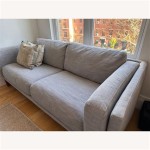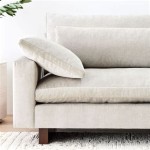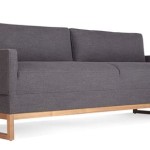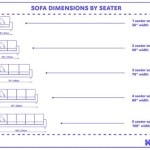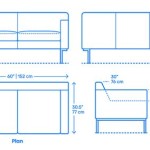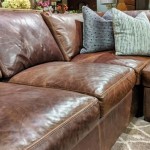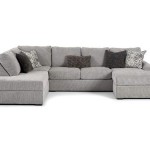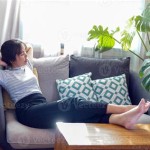Understanding Single Seater Sofa Sizes for Optimal Comfort and Space Utilization
The single-seater sofa, often referred to as an armchair or accent chair, plays a crucial role in residential and commercial spaces. It provides a comfortable seating option for one person and contributes significantly to the overall aesthetic of a room. Understanding the standard dimensions and variations in single-seater sofa sizes is essential for making informed purchasing decisions and ensuring optimal comfort and space utilization.
This article aims to provide a comprehensive overview of single-seater sofa sizes, exploring various dimensions, factors influencing size choices, and considerations for different room types. An understanding of these elements will enable individuals to select the appropriate single-seater sofa that complements their existing furniture and fulfills their specific needs.
Key Dimensions to Consider When Choosing a Single Seater Sofa
Several key dimensions define the size and suitability of a single-seater sofa. These dimensions include width, depth, height, seat height, and seat depth. Each dimension contributes to the overall comfort and ergonomic design of the sofa.
Width: The width of a single-seater sofa refers to the measurement across the front of the sofa from armrest to armrest. Standard widths typically range from 28 inches to 40 inches. A wider sofa generally provides more seating space and can accommodate larger individuals comfortably. However, a wider sofa also requires more floor space.
Depth: Depth measures the distance from the front edge of the seat to the back of the sofa. Common depths range from 30 inches to 40 inches. A deeper sofa allows for greater relaxation and can accommodate individuals who prefer to sit back and recline. However, a deeper sofa may also require more legroom and can make a room feel smaller.
Height: The height of a single-seater sofa is measured from the floor to the highest point of the backrest. Typical heights range from 30 inches to 36 inches. A higher backrest provides more support for the back and neck, while a lower backrest may offer a more modern and minimalist aesthetic.
Seat Height: Seat height is the distance from the floor to the top of the seat cushion. Standard seat heights range from 16 inches to 20 inches. The ideal seat height depends on the individual’s height and leg length. A seat height that is too low or too high can cause discomfort and strain on the knees and back.
Seat Depth: Seat depth measures the distance from the front edge of the seat to the back of the seat cushion. This dimension is often related to the overall depth of the sofa but focuses specifically on usable seating space. A deeper seat depth allows for more lounging room, while a shallower seat depth encourages a more upright posture.
Factors Influencing Single Seater Sofa Size Selection
Several factors influence the optimal size selection of a single-seater sofa. These factors include room size, intended use, individual preferences, and existing furniture styles. Careful consideration of these factors helps ensure that the chosen sofa fits comfortably within the space and meets the individual’s needs.
Room Size: The size of the room is a primary determinant of the appropriate sofa size. In smaller rooms, compact single-seater sofas with narrower widths and depths are ideal for maximizing space and preventing the room from feeling cramped. In larger rooms, larger sofas can be accommodated without overwhelming the space. Measuring the available space before purchasing a sofa is crucial to avoid fitting issues.
Intended Use: The intended use of the sofa also influences the preferred size. If the sofa is primarily intended for reading or relaxing, a deeper seat and higher backrest may be desirable. If the sofa is intended for more formal seating or conversation, a shallower seat and upright backrest may be more appropriate. Consider the activities that the sofa will be used for to determine the optimal size and features.
Individual Preferences: Personal preferences play a significant role in the selection process. Some individuals prefer wider sofas that provide ample seating space, while others prefer slimmer sofas that are easier to maneuver and position. Comfort is subjective, and individuals should choose a sofa size that feels most comfortable to them.
Existing Furniture Styles: The style of existing furniture should also be considered when selecting a single-seater sofa. The sofa should complement the existing furniture in terms of size, shape, and style. A sofa that is disproportionately large or small compared to the other furniture can disrupt the overall aesthetic of the room. Ensure that the chosen sofa integrates seamlessly with the existing décor.
Considerations for Different Room Types
The type of room in which the single-seater sofa will be placed also influences the size selection. Different rooms have different functional requirements and aesthetic considerations that should be taken into account.
Living Rooms: In living rooms, single-seater sofas are often used as accent pieces to complement larger sofas and sectional seating arrangements. The size of the single-seater sofa should be proportionate to the size of the other furniture and the overall room dimensions. A well-placed single-seater sofa can add visual interest and provide additional seating for guests.
Bedrooms: In bedrooms, single-seater sofas can create a cozy and inviting reading nook or provide a comfortable place to sit while getting dressed. Smaller, more compact sofas are typically preferred in bedrooms to avoid taking up too much floor space. The sofa should be positioned in a way that maximizes natural light and provides a relaxing atmosphere.
Home Offices: In home offices, single-seater sofas can provide a comfortable alternative to a traditional office chair. The sofa should be ergonomically designed and provide adequate support for the back and neck. A sofa with a higher backrest and firm seat cushion is ideal for promoting good posture and reducing fatigue. Consider the overall design of the office when selecting a sofa to ensure that it integrates seamlessly with the existing décor.
Entryways: In entryways, single-seater sofas can provide a welcoming place for guests to sit while removing their shoes or waiting to be greeted. Smaller sofas with shallower depths are typically preferred in entryways to avoid blocking pathways. The sofa should be durable and easy to clean to withstand the high traffic in this area.
Balconies and Patios: For outdoor spaces such as balconies and patios, single-seater sofas made from weather-resistant materials are ideal. The size of the sofa should be proportionate to the size of the outdoor space. Compact sofas with lightweight frames are easier to move and store when not in use. Ensure that the sofa is protected from the elements to prolong its lifespan.
Beyond these general considerations, specific room layouts and architectural features can further influence sofa size choices. For instance, rooms with low ceilings may benefit from sofas with lower backrests to enhance the feeling of spaciousness. Conversely, rooms with high ceilings may be able to accommodate sofas with taller backrests without feeling cramped.
The presence of architectural features like fireplaces, windows, and doorways also dictates optimal sofa placement and, consequently, size. Sofas should be positioned to maximize natural light and avoid obstructing doorways and pathways. In rooms with fireplaces, the sofa can be arranged to create a cozy seating area around the hearth.
Ultimately, the selection of the appropriate single-seater sofa size involves a careful assessment of room dimensions, functional requirements, and personal preferences. By considering these factors, individuals can choose a sofa that provides optimal comfort, enhances the aesthetic appeal of the space, and maximizes space utilization.
The material of the sofa also plays a role in perceived size and comfort. Thicker, plusher materials can add a sense of bulk, while thinner, more minimalist materials can create a sleeker profile. The choice of material should be carefully considered in conjunction with the overall size of the sofa to achieve the desired look and feel.
Furthermore, the presence or absence of armrests can significantly impact the perceived width and comfort of a single-seater sofa. Sofas with wider, more substantial armrests tend to occupy more space, while armless sofas offer a more streamlined and space-saving design. The choice of armrest style should be based on individual preferences and the overall aesthetic of the room.
In summary, selecting the right single-seater sofa size is a multifaceted process that requires careful consideration of various factors. By taking into account room dimensions, intended use, individual preferences, and existing furniture styles, individuals can make informed purchasing decisions and create comfortable and aesthetically pleasing spaces.

Nd 1 Single Seater Sofa With Cushions In Blue Colour

Flora Beige And Dark Brown Colour Single Seater Sofa

Bangkok Grey Colour Single Seater Sofa

Buy Erica Light Brown Colour Single Seater Sofa At Best In Pune

Boston Cream Brown Colour Single Seater Sofa

Teak Wood One Seater Sofa Teaklab

Bangkok Single Seater Brown Colour Sofa

Buy Ayilin Single Seater The Home Uae

Single Seater Sofa At 6000 Piece Auto Mobile Nagar Jaipur Id 20488598262

Float Single Seater Sofa

